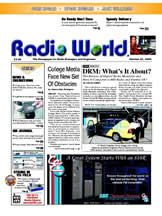|
Read
the first part of this discussion at radioworld.com, search
by key phrase "Best Practices for AM Directional Antennas."
In our earlier exciting episode we promised a real life story.
There are many and here is my favorite:
Just in time
Years
ago I was doing some contract engineering work for KKCQ- AM in
Fosston, MN, about 140 miles from home.
It was non-directional day with a three-tower
directional antenna system at night.
I just happened to be there one morning doing
maintenance in the studio/transmitter building when the 5 KW AM
transmitter shut down.
I was pushing the plate-on button when a man walked in
and said we should go out to the parking lot.
There it was, his potato chip delivery truck had
snagged a guy line and pulled the center tower down onto the
parking lot and beyond.
Trucks like that are large because potato chips take
up a lot of space while weighing next to nothing.
The
downed tower was just 197 feet so there wasn’t a resounding
crash when it fell.
Astoundlingly, no one was hurt, no vehicles were hit
and there was little other damage.
The first order of business was to call the power
company to have guy lines carefully lifted from overhead power
lines.
You
guessed it, that now-horizontal tower was the non-directional
day tower for the station.
Needless to say, the station was off the air.
Then, what to do about putting the station back on?
Well, two of the three towers were still standing.
I used some #8 electrical wire to make changes in the
phasor cabinet, sending all power into the north tower.
The tube-type transmitter ran nicely at 1000 watts
even with some VSWR.
More power was not going to happen that day because
the antenna coupling network was designed to put no more than
1000 watts into that tower.
On the positive side, I was the “hero of the day”
because the station was returned to the air just in time for
Paul Harvey’s noon news and commentary broadcast!
D vs
ND
In
the final analysis, KKCQ-AM ownership looked at losing a tower
as a blessing. The 2500 watt night directional pattern, pointing
north, served very few listeners while putting noticeable nulls
in populated areas of town, just to the west.
They elected to go non-directional day and night.
The station returned to 5 KW on the north tower during
the day with 90 watts at night.
That 90 watts is sufficient for the community and the
directional nulls are gone.
They sold the phasor and antenna monitor.
With that money, and insurance compensation, it was a
good start to building an FM station. They’ve not looked back
and have lived happily ever since.
KKCQ-AM ran a Gates BC-250GY AM
transmitter at 90 watts during night hours, which was becoming
expensive to maintain.
Replacing the transmitters with a Broadcast
Electronics AM-5A Transmitter was a wonderful choice.
That 5000 watt transmitter will run with good
sounding/clean audio at the 90 watt night power level.
The desgin is perfect for that kind of drastic power
cutback.
Most transmitter desgns can’t give good audio
performance at less than 10% of rated power output.
Another
station I worked at uses that same model BE transmitter for 5 KW
day and 30 watts at night.
It also sounds great at both power levels with no
interruption in audio as it slides between power levels.
RF contactors
Minnesota is known for actual winter temperatures that dip to 40
below zero at times. Lowest overnight temperatures usually
coencide with sunrise, a worst case scenereo.
That’s when directional AM stations switch from night
to day patterns.
Most contactors/RF relays have solenoids (AC magnets)
to pull a contact bar.
They get sluggish under cold weather conditions, as
you can imagine.
Some stations use 100 watt incandescent lamps or
electric heaters to keep tower shacks warm in winter.
If you do this, it is best to put any heat source
below an RF contactor so the heat will rise into the contactor.
Do it in a safe way so a fire is unlikely to start.
RF
contactors are wear items and will need repair from time to
time.
The stations I worked on usually had a spare
contactors on the shelf because failure is inevitable.
When replacing a contactor, I would take the failed
one to the shop for repair.
I would then put them in plastic bags and back in
stock, at the transmitter site, for the next incident.
|



